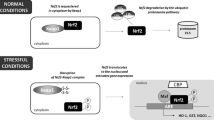Abstract
Systemic administration of N-methyl-N-nitrosourea in rats resulted in the death of retinal photoreceptors followed by differentiation of retinal Müller glial cells into photoreceptor-like cells [27]. However, mammalian Müller glial cells exhibit an extremely limited proliferative capacity, which correlates with the expression of histone γH2AX and p21 protein. These proteins are known to be components of the cellular response to DNA damage [26]. The restriction of proliferation of human Müller glial cells prevents retinal replacement therapy by cell transplantation. On the other hand, the mechanism that limits the proliferation of Müller glia in the mammalian retina remains to be elucidated. We examined the Müller glial proliferative response and the DNA damage response in Müller glia in the postreplicative stage, as well as the expression of the p53 protein in response to the influence of retinotoxic N-methyl-N-nitrosourea. It was shown that N‑methyl-N-nitrosourea induced retinal degeneration in mice via apoptosis of photoreceptors, whereas the other retinal layers retained intact morphology. Nevertheless, the formation of DNA breaks and alkali-labile sites was observed in all retinal cells 5 h after the N-methyl-N-nitrosourea injection; these formations completely disappeared 15 h after N-methyl-N-nitrosourea injection. By 72 h, a significant increase in the number of DNA breaks in Müller glial cells was observed. The absence of bromodeoxyuridine incorporation into the retinal cells later testifies to the absence of proliferation of Müller glial cells and DNA repair synthesis. At the same time, an increased expression of the p53 protein, a universal marker of DNA damage, was observed in the retina. Thus, our findings support the concept of the “DNA damage response” with respect to Müller glial cells, according to which the DNA damage in Müller glial cell is related to the restricted proliferation of these cells in mice. Postreplicative repair is considered as a probable mechanism of the formation of DNA breaks in postreplicative Müller glial cells.







Similar content being viewed by others
REFERENCES
S. A. Jayakody, R. R. Gonzalez-Cordero Ali, and R. A. Pearson, Prog. Retin. Eye Res. 46, 66 (2015).
D. Lamba, M. Karl, and T. Reh, Cell Stem Cell 2, 538 (2008).
J. G. Monzon, N. Hammad, S. D. Stevens, and J. Dancey, Oncologist 17, 384 (2012).
V. A. Tronov and E. I. Nekrasova, Vopr. Onkol. 64, 555 (2019).
A. Tsubura, K. Yoshizawa, M. Kuwata, and N. Uehara, Histol. Histopathol. 25, 933 (2010).
M. O. Karl, S. Hayes, B. R. Nelson, et al., Proc Natl. Acad. Sci. U. S. A. 105, 19508 (2008).
G. P. Lewis, E. A. Chapin, G. Luna, et al., Mol. Vis. 16, 1361 (2010).
K. Yoshizawa, T. Sasaki, N. Uehara, et al., J. Toxicol. Pathol. 25, 27 (2012).
L. A. Ostrovskaya, V. A. Filov, B. A. Ivin, et al., Ros. Bioterapevt. Zh. 3, 24 (2004).
V. A. Tronov, E. I. Nekrasova, and M. A. Ostrovskii, Tsitologiya 60, 440 (2018).
K. Konca, A. Lankoff, A. Banasik, et al., Mutat. Res. 534, 15 (2003).
M. Yu. Loginova, V. A. Tronov, T. A. Beletskaya, et al., Radiats. Biol. Radioekol. 48, 698 (2008).
The TACS 2 TdT Fluorescein Kit. https://trevigen.com/docs/protocol/protocol_4812-30-K.pdf.
V. A. Tronov and E. M. Konstantinov, Biochemistry (Moscow) 65 (11), 1279 (2000).
D. T. Beranek, Mutat. Res. 231, 11 (1990).
D. Fu, J. A. Calvo, and L. D. Samson, Nat. Rev. Cancer 12, 104 (2012).
L. B. Meira, C. A. Moroski-Erkul, S. L. Green, et al., Proc. Natl. Acad. Sci. U. S. A. 106, 888 (2009).
M.-C. Koag, Y. Kou, H. Ouzon-Shubeita, and S. Lee, Nucleic Acids Res. 42, 8755 (2014).
V. A. Tronov, E. M. Konstantinov, and I. I. Kramarenko, Biochemistry (Moscow) 67 (7), 730 (2002).
M. Allocca, J. J. Corrigan, K. R. Fake, et al., Oncotarget 8, 68707 (2017).
D. Ahel, Z. Horejsi, N. Wiechens, et al., Science 325, 1240 (2009).
W. Ying, M. B. Sevigny, Y. Chen, and R. A. Swanson, Proc. Natl. Acad. Sci. U. S. A. 98, 12227 (2001).
W. Cao, J. Tombran-Tink, R. Elias, et al., Invest. Ophthalmol. Vis. Sci. 42, 1646 (2001).
V. A. Tronov, Yu. V. Vinogradova, M. Yu. Loginova, et al., Tsitologiya 54, 261 (2012).
Y. Ueki, M. O. Karl, S. Sudar, et al., Glia 60, 1579 (2012).
J. Wan, H. Zheng, Z-L. Chen, et al., Vis. Res. 48, 223 (2008)
K. Nomura-Komoike, F. Saitoh, Y. Komoike, and H. Fujieda, Invest. Ophthalmol. Vis. Sci. 57, 1169 (2016).
Funding
This work was supported by the Russian Foundation for Basic Research (project no. 16-04-00133).
Author information
Authors and Affiliations
Corresponding author
Ethics declarations
Conflict of interest. The authors declare no conflict of interest.
Statement on the welfare of animals. All procedures with animals were carried out in accordance with the Regulations of the Ethics Committee of the Emanuel Institute of Biochemical Physics, Russian Academy of Sciences.
Additional information
Translated by M. Batrukova
Abbreviations: MGC, Müller glial cells; BrdU, bromodeoxyuridine; MNU, methylnitrosourea; PBS, phosphate-buffered saline.
Rights and permissions
About this article
Cite this article
Tronov, V.A., Nekrasova, E.I. DNA Damage and p53 Restrict Proliferation of Müller Cells in the Mouse Retina in Response to the Influence of N-Methyl-N-Nitrosourea. BIOPHYSICS 65, 460–467 (2020). https://doi.org/10.1134/S0006350920030215
Received:
Revised:
Accepted:
Published:
Issue Date:
DOI: https://doi.org/10.1134/S0006350920030215




